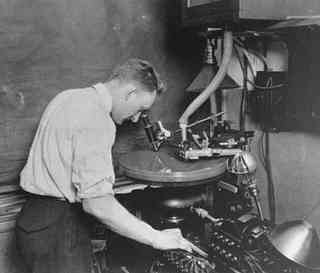 Vitaphone engineer George Groves at a 1925 electrical disc recording machine, photo from AT&T exhibit "The Dawn of Sound" Vitaphone engineer George Groves at a 1925 electrical disc recording machine, photo from AT&T exhibit "The Dawn of Sound" |
John Mullin demonstrates a Vitaphone disk lathe ca. 1927, clip from An Afternoon With John T. Mullin videotape produced by the Audio Engineering Society. John Mullin was born in San Francisco in 1913 and spent a lifetime as an engineer, inventor, collector and historian of recording devices. |